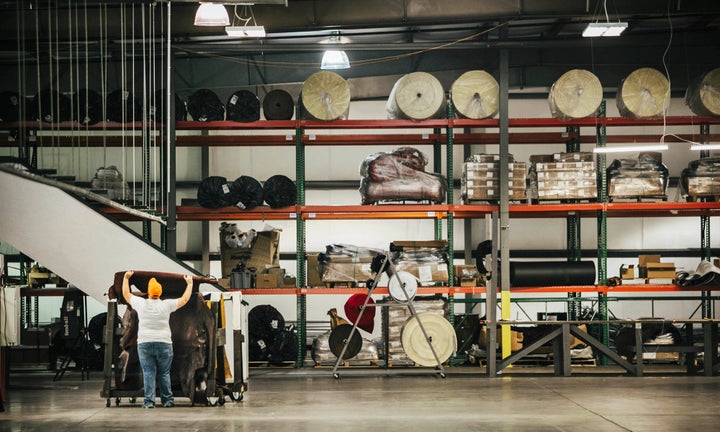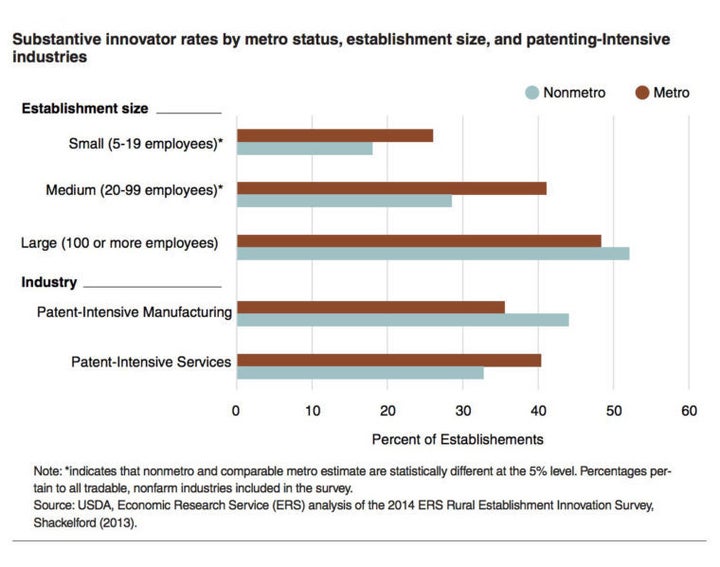Rural areas may be as innovative as urban ones in some instances. The finding contradicts conventional wisdom that urban areas have a lock on innovation.

A boot manufacturing plant in Morristown, Tennessee.
By Bryce Oates and Tim Marema
Large manufacturing firms in rural America are at least as likely as similar urban firms to use innovative methods that can contribute to job creation and increased earnings, a new report says.
Though preliminary, the study may indicate that there are exceptions to the oft-repeated rule that economic innovation is the nearly exclusive purview of urban-based businesses.
“The findings in this report regarding the prevalence of rural innovation challenge the conventional wisdom that rural nonfarm innovation is relatively rare and idiosyncratic,” the report says. While large rural manufacturers had an innovation edge, that finding did not hold true for small and medium-sized rural manufacturers, the study shows. (See bar chart below.)
The study by the USDA’s Economic Research Service looked at non-farm rural economic sectors like manufacturing and services, which have not received as much attention from rural economists as agriculture-related activities. The research looked at the years 2010-2014, which correspond with the period of economic recovery following the Great Recession.
The researchers found that a majority of rural manufacturers with 100 or more employees were “substantive innovators.” That means those firms did things like reform their business practices based on customer feedback, create new products or significantly modify old ones, analyze data to evaluate progress and efficiency, and use trade-secret protections like non-disclosure agreements or non-compete clauses.

About 53 percent of large rural manufacturers met the criteria to be considered “substantive innovators.” Only about 49 percent of large urban manufacturers met those criteria.
The approximate difference of 4 percentage points between rural and urban innovation rates fell within the study’s margin of error, however. That means the numbers represent a kind of statistical tie.
Even with a statistical dead heat, the finding is remarkable because of assumptions that urban areas have a big innovation advantage from factors such as larger skilled-labor pools and better information and supply networks, said report co-author Tim Wojan in an email. Timothy Parker co-authored the study.
“This preliminary analysis supports the hypothesis that continuous improvement programs, data-driven decision making, and more far-ranging innovation activities were associated with faster recovery from the Great Recession,” the study said.
Wojan and Parker found that the bulk of innovative rural manufacturers were in the sectors of pharmaceuticals, chemicals, computers, plastics, and textiles. Some examples of innovations are the use of robotics to produce textiles, smart-phone based transportation services, and higher-speed internet communications systems.
The study also showed that job growth was faster in innovation-intensive rural industries, compared to non-innovative ones. Innovative enterprises added 153,736 jobs during the recovery from the Great Recession. That’s a growth rate of 8.4 percent. Non-innovative firms added 130,345 jobs, a 5.4 growth rate.
“Despite this growth from 2010 to 2014, the number of jobs in rural America is still lower today than it was in 2008 before the recession.”
Despite this growth from 2010 to 2014, the number of jobs in rural America is still lower today than it was in 2008 before the recession. In comparison, metropolitan America regained all its lost jobs by 2013 and had about 5 percent more employment at the end of 2016 than it did before the recession.
The strongest employment growth in the rural innovation sector during the economic recovery period came from transportation equipment, beverages and tobacco, machinery manufacturing, scenic/sightseeing transportation, fabricated metals, and data processing. For the non-innovation sector, the strongest growth was seen in mining support activities, water transportation, oil and gas, and pipeline activities. Significant decreases were found in the rural communications sector, including publishing, broadcasting, printing, and telecommunications.
The researchers used the 2014 Economic Research Service Rural Establishment Innovation Survey (REIS). REIS is the first nationally representative sample of self-reported innovation in rural communities, designed to “examine the impetus, outcomes, and prevalence of rural innovation.”
